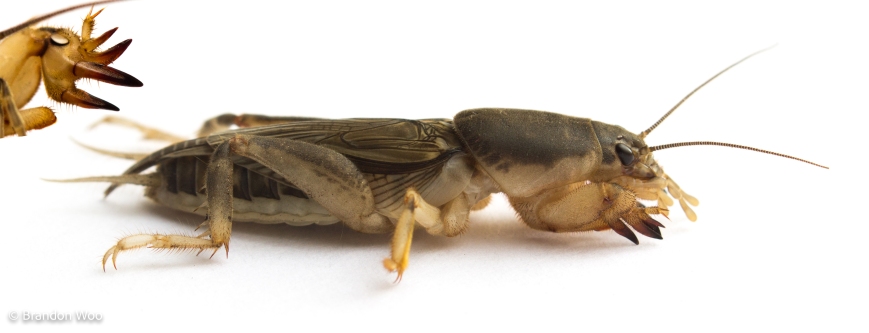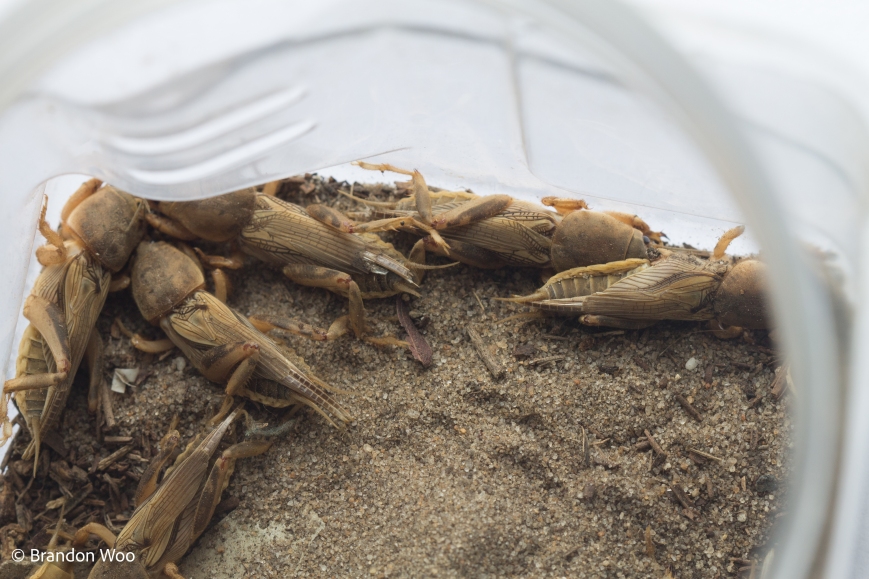
A tawny mole cricket (Neoscapteriscus vicinus) at Archbold Biological Station, FL.
The large dark shape on the ground in front of me seemed to sense my approach. It made a strange little hop and started rapidly running in the opposite direction. I knew immediately what it was and immediately caught hold of the fleeing creature. Wow, a mole cricket! And oh look, there was another, and another…
Mole crickets are some of those insects that you hear about in intro entomology classes, but rarely see for yourself. They represent their own family (Gryllotalpidae) of strange orthopterans, found pretty much worldwide. True to form, their front legs are highly modified for digging and bear a strong resemblance to the forelegs of actual moles. They tend to have a very similar body plan wherever in the world you encounter them. 7 species of mole crickets inhabit the continental U.S, but the only ones commonly seen are the 3 introduced species of the genus Neoscapteriscus found in the southeastern states. All were introduced from South America in the early 1900s and have since become serious pests of open grassy areas. One species, the southern mole cricket (N. borellii) is primarily carnivorous, but still causes damage by digging through roots. The lesser shortwinged mole cricket, N. abbreviatus, is a herbivore that loves grass roots and can cause major damage, but it has extremely reduced wings (hence the common name) and thus is only a problem in a few restricted sites. The worst offender of them all is the tawny mole cricket, N. vicinus, which is both herbivorous and fully winged, capable of doing a lot of damage and spreading rapidly to colonize new turf.

Tawny mole cricket, Neoscapteriscus vicinus. Note that the tibial dactyls (bottom pair of large ‘claws’) almost touch at their bases.
Back to the encounter. I quickly snatched all three mole crickets and dashed to my room. I was staying at the Archbold Biological Station near Venus, FL, a ridiculously diverse place containing some of the last remaining Florida Scrub habitat on the planet. There is a recently built guest lodge on the premises that hosts very nice accommodations as well as (most importantly) bright lights that attract plenty of insects. Into a plastic container went the mole crickets, and out the door I flew to see what else had arrived at the lights. Every few steps I took, I stopped to pick up another mole cricket, and another, and another. When I finally rounded the corner to the stairwell where most insects accumulated, I was greeted by mole crickets galore. They came barreling in from the darkness, hitting the ground with a thud. They jumped and flew about a few times before scuttling right and left across the pavement. If they reached a patch of soil they dug down and then came right back up to fly once more. I had seen mole crickets a few times in the past, but never like this. It was unbelievable to me that these large, heavy-bodied animals could even lift themselves off the ground, let alone fly about in droves. In the end I caught a grand total of about 30 mole crickets, all N. vicinus except for a lone N. borellii that seemed to be completely clueless among its larger, more active congeners.

Southern mole cricket, Neoscapteriscus borellii. The tibial dactyls are widely separated at their bases in this species.
I kept the mole crickets in a large tank with soil from around the station for several weeks. They were easy to keep and weren’t picky eaters. I would drop pieces of carrot, grape, apple, and other fruits and veggies on the soil surface, and the mole crickets would quickly drag the food into their burrows. They probably wouldn’t have been too difficult to breed, but breeding more of an invasive species felt like the wrong thing to do, so I didn’t try.

Just a few of the many Neoscapteriscus mole crickets that swarmed the lights at Archbold that spring evening.
